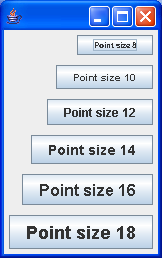ColumnLayout

/*
* Copyright (c) 2000 David Flanagan. All rights reserved.
* This code is from the book Java Examples in a Nutshell, 2nd Edition.
* It is provided AS-IS, WITHOUT ANY WARRANTY either expressed or implied.
* You may study, use, and modify it for any non-commercial purpose.
* You may distribute it non-commercially as long as you retain this notice.
* For a commercial use license, or to purchase the book (recommended),
* visit http://www.davidflanagan.com/javaexamples2.
*/
import java.awt.Component;
import java.awt.Container;
import java.awt.Dimension;
import java.awt.Font;
import java.awt.event.WindowAdapter;
import java.awt.event.WindowEvent;
import java.awt.Insets;
import java.awt.LayoutManager2;
import javax.swing.JButton;
import javax.swing.JFrame;
import javax.swing.JPanel;
/**
* This LayoutManager arranges the components into a column. Components are
* always given their preferred size.
*
* When you create a ColumnLayout, you may specify four values: margin_height --
* how much space to leave on top and bottom margin_width -- how much space to
* leave on left and right spacing -- how much vertical space to leave between
* items alignment -- the horizontal position of the components:
* ColumnLayout.LEFT -- left-justify the components ColumnLayout.CENTER --
* horizontally center the components ColumnLayout.RIGHT -- right-justify the
* components
*
* You never call the methods of a ColumnLayout object. Just create one and make
* it the layout manager for your container by passing it to the addLayout()
* method of the Container object.
*/
public class ColumnLayout implements LayoutManager2 {
protected int margin_height;
protected int margin_width;
protected int spacing;
protected int alignment;
// Constants for the alignment argument to the constructor.
public static final int LEFT = 0;
public static final int CENTER = 1;
public static final int RIGHT = 2;
/** The constructor. See comment above for meanings of these arguments */
public ColumnLayout(int margin_height, int margin_width, int spacing,
int alignment) {
this.margin_height = margin_height;
this.margin_width = margin_width;
this.spacing = spacing;
this.alignment = alignment;
}
/**
* A default constructor that creates a ColumnLayout using 5-pixel margin
* width and height, 5-pixel spacing, and left alignment
*/
public ColumnLayout() {
this(5, 5, 5, LEFT);
}
/**
* The method that actually performs the layout. Called by the Container
*/
public void layoutContainer(Container parent) {
Insets insets = parent.getInsets();
Dimension parent_size = parent.getSize();
Component kid;
int nkids = parent.getComponentCount();
int x0 = insets.left + margin_width; // The base X position
int x;
int y = insets.top + margin_height; // Start at the top of the column
for (int i = 0; i < nkids; i++) { // Loop through the kids
kid = parent.getComponent(i); // Get the kid
if (!kid.isVisible())
continue; // Skip hidden ones
Dimension pref = kid.getPreferredSize(); // How big is it?
switch (alignment) { // Compute X coordinate
default:
case LEFT:
x = x0;
break;
case CENTER:
x = (parent_size.width - pref.width) / 2;
break;
case RIGHT:
x = parent_size.width - insets.right - margin_width
- pref.width;
break;
}
// Set the size and position of this kid
kid.setBounds(x, y, pref.width, pref.height);
y += pref.height + spacing; // Get Y position of the next one
}
}
/** The Container calls this to find out how big the layout should to be */
public Dimension preferredLayoutSize(Container parent) {
return layoutSize(parent, 1);
}
/** The Container calls this to find out how big the layout must be */
public Dimension minimumLayoutSize(Container parent) {
return layoutSize(parent, 2);
}
/** The Container calls this to find out how big the layout can be */
public Dimension maximumLayoutSize(Container parent) {
return layoutSize(parent, 3);
}
// Compute min, max, or preferred size of all the visible children
protected Dimension layoutSize(Container parent, int sizetype) {
int nkids = parent.getComponentCount();
Dimension size = new Dimension(0, 0);
Insets insets = parent.getInsets();
int num_visible_kids = 0;
// Compute maximum width and total height of all visible kids
for (int i = 0; i < nkids; i++) {
Component kid = parent.getComponent(i);
Dimension d;
if (!kid.isVisible())
continue;
num_visible_kids++;
if (sizetype == 1)
d = kid.getPreferredSize();
else if (sizetype == 2)
d = kid.getMinimumSize();
else
d = kid.getMaximumSize();
if (d.width > size.width)
size.width = d.width;
size.height += d.height;
}
// Now add in margins and stuff
size.width += insets.left + insets.right + 2 * margin_width;
size.height += insets.top + insets.bottom + 2 * margin_height;
if (num_visible_kids > 1)
size.height += (num_visible_kids - 1) * spacing;
return size;
}
// Other LayoutManager(2) methods that are unused by this class
public void addLayoutComponent(String constraint, Component comp) {
}
public void addLayoutComponent(Component comp, Object constraint) {
}
public void removeLayoutComponent(Component comp) {
}
public void invalidateLayout(Container parent) {
}
public float getLayoutAlignmentX(Container parent) {
return 0.5f;
}
public float getLayoutAlignmentY(Container parent) {
return 0.5f;
}
}
class ColumnLayoutPane extends JPanel {
public ColumnLayoutPane() {
// Get rid of the default layout manager.
// We'll arrange the components ourselves.
this.setLayout(new ColumnLayout(5, 5, 10, ColumnLayout.RIGHT));
// Create some buttons and set their sizes and positions explicitly
for (int i = 0; i < 6; i++) {
int pointsize = 8 + i * 2;
JButton b = new JButton("Point size " + pointsize);
b.setFont(new Font("helvetica", Font.BOLD, pointsize));
this.add(b);
}
}
public static void main(String[] a) {
JFrame f = new JFrame();
f.addWindowListener(new WindowAdapter() {
public void windowClosing(WindowEvent e) {
System.exit(0);
}
});
f.setContentPane(new ColumnLayoutPane());
f.pack();
f.setVisible(true);
}
}
Related examples in the same category